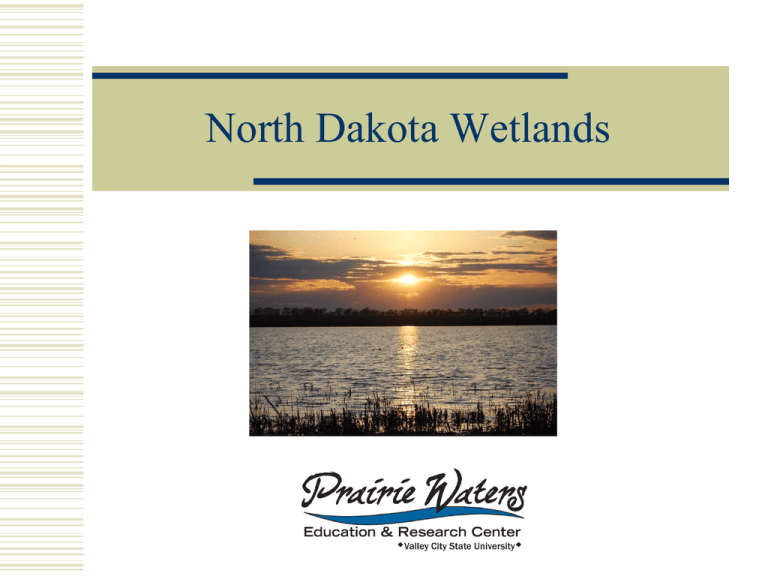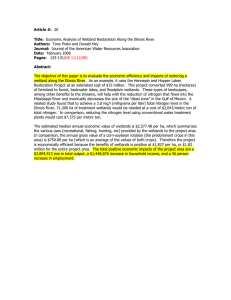North Dakota Wetlands Power Point
advertisement

North Dakota Wetlands Wetlands AKA: pothole, slough, swamp Are basins or low areas that hold water. Can be for days, weeks, months, or all year Are fed by watersheds – areas of land that drain water from the highest point to the lowest point A wetland is a low point of a watershed. Wetland Formation Glaciers formed most of the ND wetlands. The last glacier entered ND from Canada 40,000 years ago It covered all but the southwest corner of ND (the Badlands) As it moved, it scraped the land flat to form prairies, deposited sediments to create hills, and scooped out areas to make lakes and sloughs (potholes) This is what created the “Prairie Pothole Region”. Prairie Pothole Region Made of prairies, rolling hills, and potholes Covers 30,000 square miles including parts of Alberta, Saskatchewan, Manitoba, Montana, North Dakota, South Dakota, Minnesota, and Iowa Is the greatest area of waterfowl production in the world! 3 Common Characteristics of Wetlands Water-have water present at times Hydric soil – soil that was formed in anaerobic conditions (without oxygen) because it was saturated with water Plants that can live in water—”hydrophyic” Types of hydrophytic vegetation - Emergent (cattails, rushes, sedges, grasses, trees, shrubs) - Floating (duckweed) - Submergent (coontail, sego) Wetland Vegetation • Dominated by hydrophytes • Prolonged wetness of land area excludes most plants from growing • Hydrophytes have special adaptations to withstand the stressful conditions characteristic of a wetland (little oxygen, fluctuating water levels) Wetland Zones Open Water Shallow Marsh Wet meadow Low prairie Upland prairie Wetland Zones Low Prairie Zone Shallow Marsh Zone Deep Marsh Zone Wetlands can be thought of as transition zones between land and water. Wetland Zones Low prairie Shallow marsh Deep marsh Permanent open water Wet meadow Wetlands Need Changing Water ► Diversity of wetland types and depths ► Plant diversity in each zone decreases as water permanence increases Wetland Soils - Soil / substrate saturation at or near the surface - Anaerobic reducing conditions that effect plants growth and inhibit t of microorganisms (“sulphur” smell from bacteria) - Certain types of soils are present in wetlands= hydric soils - As water fills the air spaces between soil particles, the rate at which Can diffuse through the soil decreases significantly Hydric Soil classification - Organic or mineral - Organic wetland soils contain lots of partially decayed plant and anim matter. Water saturated and oxygen poor conditions inhibit the growth Microorganisms that decompose organic material. This creates a thick or dark brown layer at the soil surface. (peat or muck) - Mineral wetland soils contain less organic material and more sand, s They are generally lighter in color than organic soils Munsell Color Book -used to identify soils types by soil scientists 4 Major Types of Wetlands Categorized by how much water they contain and when they contain water Temporary Wetlands Seasonal Wetlands Semi-Permanent Wetlands Permanent Wetlands Temporary Wetlands Shallow depressions that hold water from melting snow or heavy rain Last only a couple weeks, then dry up Important to migratory birds because they warm up quickly in the spring providing a place for them to stop and feed Nesting waterfowl rely on the protein-rich invertebrates that occur in temporary wetlands to meet the high nutritional demands of egg laying. Seasonal Wetlands Depressions that usually contain water from snow melt to mid-July Usually are not planted for crops but may be used for pasture or hay. Seasonal Wetlands continued Have two vegetation zones Wet Meadow – outer zone – contains fine-textured grasses, sedges, and rushes Shallow Marsh – central zone consists of an area of low, soggy land with a large variety of aquatic vegetation Provide nesting habitat, brood cover, and food for many birds Wet Meadow Shallow Marsh Temporary and Seasonal Wetlands Studies indicate that temporary and seasonal wetlands comprise about 35 percent of the wetland area in North Dakota, but support 57 percent of the breeding waterfowl population. Semi-Permanent Wetlands Basins that hold water all year except in very dry years Hydrophytic “water loving” plants such as cattails Semi-Permanent Wetlands continued Have three vegetation zones Wet Meadow – outermost zone Shallow Marsh – between the other two zones Contains fine-textured grasses, sedges, and rushes Consists of an area of low, soggy land with a large variety of aquatic vegetation Deep Marsh – central zone Contains fully submerged aquatic vegetation Wet Meadow Shallow Marsh Deep Marsh Permanent Wetlands Hold water all year and only go dry after many years of drought Most are large and deep – Lakes Less important to migratory birds and wildlife but do usually contain fish Water is often alkaline Permanent Wetlands continued Have four vegetation zones Central deep water - has no vegetation Deep marsh – contains fully submerged aquatic vegetation Shallow marsh – consists of an area of low, soggy land with a large variety of aquatic vegetation Wet meadow – contains finetextured grasses, sedges, and rushes Wet Meadow Shallow Marsh Deep Marsh Central Deep Water Other Types of Wetlands Saline Wetlands – salty Have no vegetation zones Have muddy, sandy, rocky and pebble lined shores that are often salt-covered Provide nesting areas for the threatened piping plover and rest stops for migratory waterfowl like sandhill cranes Other Types of Wetlands continued Fens – areas found on sloping river valleys and in the Turtle Mountains Are fed by year-round seepage from groundwater Other Types of Wetlands continued Bogs – similar to fens but have a lot of dead plant material 3 Major Natural North Dakota Regions Increase in elevation as move from east to west Red River Valley Drift Prairie Missouri Plateau Red River Valley The floor of ancient Lake Agassiz which formed when glaciers in Canada blocked the flow of water Area is extremely flat which causes it to have fewer wetlands Oxbow lakes are common Drift Prairie Glaciated plains Contains the largest number of wetlands and the most temporary and seasonal wetlands Missouri Plateau Highest land in the state West of the Drift Prairie to the Montana border Eastern part is called the Missouri Couteau Contains larger, deeper, and more permanent wetlands than Drift Prairies and has more semipermanent wetlands than the rest of the state Wetland Wildlife Aquatic Macroinvertebrates – essential to the food chain Includes aquatic insects and other invertebrates which hatch or live in water Provide food to many wetlands animals Help keep wetlands clean by eating dead plant and animal matter in the water Filter particles out of water so it is clean and sunlight can reach the plants on the wetland floor Wetland Wildlife continued Birds – ND wetlands are one of the most important areas for waterfowl breeding in North America Includes: Ducks, Mergansers, Geese, Swans, Pelicans, Wading Birds, Grebes, Shorebirds, Cranes, Gulls and Terns, and Songbirds Wetland Wildlife continued Amphibians – lay eggs in or near water and use wetlands for their larval tadpole and for food Are sensitive to environmental pollutants because their skin absorbs the poisons Reptiles – often use wetlands as habitat Wetland Wildlife continued Mammals – include many fur-bearing mammals like beaver, muskrats, mink, and raccoons Use area for food, to build homes with, and cover Wetland Wildlife continued Fish – found in permanent wetlands Include Northern Pike, Walleye, Yellow Perch, Sunfish, Catfish, Paddlefish, Trout, Sturgeon, etc. Importance of Wetlands 1. Home to a large variety of plants, animals, and invertebrates 2. Natural Flood Control – store water when snow melts and after heavy rainfall Slowly releases this stored water by evaporation or drainage Increases soil moisture for crops Reduces the amount of water that quickly flows into rivers and lakes which can cause flooding Importance of Wetlands continued 3. Improves Water Quality – helps remove pollutants from water Pollution comes from sewage, manufacturing plants, fertilizers, pesticides, herbicides, etc. As water is stored in a wetland, the plants absorb and filter pollutants from the water Importance of Wetlands continued 4. Recharges Groundwater – water seeps into the ground to refill aquifers 5. Public Use – hunting, fishing, trapping, swimming, boating, birdwatching, etc. Threats to Wetlands Draining – In the past, ND’s landscape was 11% wetlands = 5 million acres In the last century, almost half have been lost People drain wetlands for construction of homes, highways, dams, dikes, farming, and other human activities Threats to Wetlands continued Sedimentation – soil erosion by runoff carries the soil to wetlands and deposits it Causes buildup of soil that can make lakes shallow and harm habitat Threats to Wetlands continued Nutrification – when nutrients are carried to rivers and lakes causing algae blooms • Uncontrolled algae blocks sunlight so plants and algae in lower levels die. • Bacteria break these down and use up oxygen in this process causing death to both aquatic plants and animals – eutrophication • Nutrients often come from runoff from farm fertilizers, cattle manure, and soil Aquatic Nuisance Species plants or animals that have been introduced to a wetland and are harmful to it Examples – curly leaf pondweed, purple loosestrife, zebra mussel, carp, Eurasian water milfoil, salt cedar, spiney water flea Preserving Wetlands Important because wetland habitats are one of the most productive ecosystems in the world They play an important role in our economy


